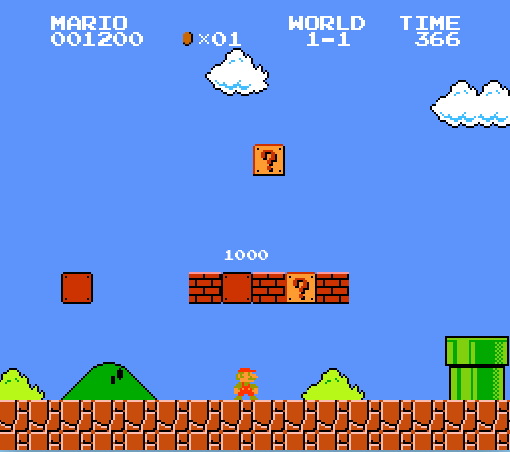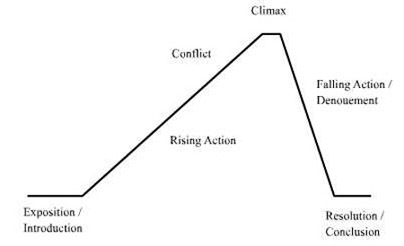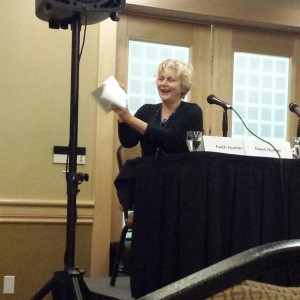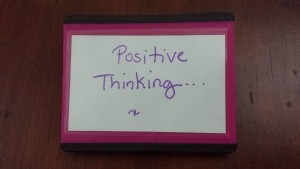Kate Larking's Blog: Anxiety Ink, page 47
September 3, 2015
Annihilating the Everywoman

If you caught my post about my When Words Collide attendance this year, you’ll have seen that one of my favourite panels was Strong Female Characters. Since I’ve been attending the conference, there have always been panels devoted to female characters. This year, however, proved incredibly insightful on the topic.
One of the most relevant –at least for me and my WIP– comments that arose was this (which I paraphrased and then added to):
The Strong Female Character is NOT the everywoman. The everywoman arises when you only have one woman on your team, which relegates that woman to the role of being every kind of woman. It is completely unrealistic for a woman to be altogether smart/dumb, sexy/virginal, vulnerable/independent, damsel in distress/butt kicker –all the gendered binaries we place on women. The solution is simple: have more women!

In my WIP, I do have more than one woman in my cast, and the story is written in first person from the perspective of my SFC. She’s a woman who dominates what many would consider a male profession (bounty hunting), she was raised in a military environment with military ideals (patriarchy), and she was raised largely by her father and then her uncle.
I did this on purpose, obviously. But I also turned her into a rebel against the tom boy persona that she felt was thrust on her in her early years. It’s more nuanced than that, but the basic gist will do here. As an adult, she’s grown her hair out long from the pixie cut she’s had for over half her life and she enjoys fashion, just to name two wonderfully gendered things everyone will understand on delivery. I turned her into this conqueror of what can be perceived as the quintessential male and female worlds.
Then this comment arose in this panel. And I really thought about my character. And I thought of a lot of girls I know.
This may be a shock to you, but not all women can walk in stilettos. Or even shoes with a slight heel. And none of us is born knowing how to walk in them. We’re taught by our mothers, grandmothers, sisters, friends…. We learn to walk in heels by imitating those we see wear them. It’s an art form. And not one all of us master.

Rock a Republic red suede stilettos by Maegan Tintari via Flickr
Grasping on this, my mind circled to Tamora Pierce’s Lioness Quartet. For those of you who have read it, I seized on the scene where Alanna is walking in a dress in the royal garden and Jonathan sees her from a window. When she asks him how he knew it was her, he answers her bluntly: only she could go about in a dress and still walk like a man.
*epiphany*
For those of you who haven’t read the Lioness Quartet, that is your homework!
Alanna has been in knight training since her preteen years. She’s never interacted with other women as a woman. She’s quite literally one of the guys. My character has a similar backstory. Her father had more pressing concerns than dressing her up and teaching her how to be feminine. She can walk as quiet as a wraith, but in my head she can’t strut in heels.
After realizing I was turning her into an everywoman –really, into the perceived male fantasy of the woman who is all things (one of the guys, the girl next door, a sex kitten, etc.)– I had to step back. And you know what, I think my character makes a lot more sense now that I’ve acknowledged this dimension of her.
She kicks ass and takes names. And she doesn’t need high heels to do it. They would just piss her off.
Most importantly, she has vulnerabilities and insecurities like any other human. At least I got that right from the get go.

The post Annihilating the Everywoman appeared first on Anxiety Ink.
September 2, 2015
When Words Collide 2015 Recap – World-building Presentation from Game Design

Continuing on in my When Words Collide 2015 recap, I’m finally moving into the regular programming portion of the festival. This one is about Susan Forest’s world-building presentation on Crafting Magical Worlds with Extra Credits’ Mario Theory.
The reason why I wanted to include this one is because it really blew my mind. I love finding parallels between written storytelling and other storytelling media like games. And Susan Forest presented it wonderfully with the parallel between solid world-building techniques in both mediums.
A lot of the time, stories convey world-building, such as how magic systems work, with some three methods that kind of break the flow:
Telling with exposition. I remember when…
Prologues. Worst idea ever.
Dialogue. ”As you know Bob…” “Let me explain how magic works…”
Game design tends to rely on tutorials, similar to prologues in fiction. It doesn’t get you into the game right away. It’s an infodump that you have to make it through–and readily recall later–in order to survive the battle or scenario coming up. However:
Too much information up front slows the pace.
Too little information and the reader doesn’t know what is happening.
But in old school Super Mario Bros., there was no tutorial. No infodump. You started in the middle of the screen. Only one movement allowed for the scenery to change (moving right). As you encounter blocks, question boxes, enemies, and jumping over obstacles, you learned how to do things precisely when you needed them. In addition, shown information is more memorable than told information. Conflict, action, and characters are what readers care about and will make your world-building more memorable.
The final thing that really resounded with me was the difference between world-building depth and world-building complexity. Depth was the ability for the reader/player to make decisions and get engaged with the world. Complexity is the number of rules a constructed world has. While a certain about of rules are necessary to achieve depth, too much complexity in world-building might act as a barrier to depth.
Complexity can be lowered if built off of existing lore. But if you are calling on a previous understanding of the complexity presented in your book, you need to be clear which lore or convention you are building on. Stupid example: are your vampires deadly or sparkly?
Needless to say, world-building for me was so much more clearly presented with the as-needed Mario theory for genre fiction. The comparison brought the needs of fiction into focus for me that generic writing advice hadn’t done for me in some time.

The post When Words Collide 2015 Recap – World-building Presentation from Game Design appeared first on Anxiety Ink.
August 31, 2015
Tone; or, Now I Understand Stephen King

A side effect of having moved back to Maine five years ago: this state is creeping into my stories.
Not only are more and more ideas set here, but the tone and mood of the stories are changing. They’re becoming darker.
All right. There are more factors at work than just geography. Five years ago – the precipitate for the move home from Seattle – my dad died. That’s one of those moments that break life into a definite ‘before’ and ‘after.’ It certainly changed me on a fundamental level. Of course, it changed and continues to change my writing.
Then there’s the fact that I’m a better writer now than I was five years ago. I consciously write on more levels. I allow myself to go to deeper and darker places now, push characters further and raise stake higher.
This new novel – the one I’m typing – is the one that made me realize the trending tone. Many of my ideas over the last five years share a certain mood. (At least for those stories set in Maine.) If I have to describe it, it feels like dark forests and dense sea fog.
You know, I think I’ve begun to understand Stephen King. A tiny bit. Maybe.
Now if only the execution can halfway match what is in my head . . .

The post Tone; or, Now I Understand Stephen King appeared first on Anxiety Ink.
August 27, 2015
Positivity

Since Kate, Melissa, and I started our annual New Year’s goals challenge, even before that, I’ve listed “be positive” or “be more positive” as one of my aspirations each time. I like to think I’m not a wholly negative person, although I do admit I’m prone to seeing the glass half-empty.
I list this item every year and think that just because I have listed it, something is going to magically change to make me more positive. Where’s my genie at? Unfortunately, life does not work that way.
After years of repeat, I decided I was completely sick of the lack of positivity in my life and my seeming inability to change it. So I came up with a means to implement change. In December of last year, I went to Staples and bought another adorable mini-binder, like the one I use for word tracking, and turned it into my little positivity gem.
Every day, before I go to bed, I sit and think about one positive thing I can write down in my binder. I’m not allowed to leave my desk until I do. Some days are harder than others, but there’s always something good that occurred. Even if a moment just made me smile on a bad day, I write it down. I won’t lie, my cats make it into the binder often.
At first it was difficult to just remember to write something down, so I have the task listed as one of my daily to-do’s in my agenda. That’s accountability.
It might seem silly and overly easy to write something nice every day. I can tell you it actually works. And believe me, I’m as surprised as anyone. But writing something positive each day, even simply taking the time to look for something positive at the end of the day and sleeping on that positive thought, does wonders. There have been days where my whole demeanor has shifted. There have also been days where I’ve sat for a good twenty minutes trying my damnedest to think of something good that happened.
My bad days have been fewer and far between since I wrote my first positive thought on January 1st. I waited until I filled my binder to decide whether my experiment was worthwhile; that happened July 18. We’re now almost out of August and I’ve since restocked my binder and have kept up my trend.
I’m crossing this goal off my list when my next update comes around.
Have you taken steps in your life to increase your positivity or are you just naturally positive?

The post Positivity appeared first on Anxiety Ink.
August 26, 2015
When Words Collide 2015 Recap – Lessons from a Plot Workshop within an Unfamiliar Genre

Continuing on in my When Words Collide 2015 recap, the second workshop I attended was the Plot Workshop with Daniel Abraham (aka HLN Hanover, aka half of the pen name James S. A. Corey).
His definition of plot was the following:
The series of events that make up your story and the order in which they are presented.
Totally makes sense, right? This definition action accounts for non-linear presentations in fiction. More sense than this picture:

Source
Each story scene presented must deliver on the following three sections in order for the story to be tight:
Narrative: literal action going on in the scene.
Informative: what information do you need the reader to take away in order for this scene to make sense.
Functional: what the scene is doing in the story.
Now, this leads up to something that he said that really struck me. “A strong plot is independent of the story’s content.” What does this mean? It really doesn’t matter what is contained in the narrative side of the scene. The main focus for plot structure is on the functional side of the scene and whether the information presented ties together in the full functional outline of the story.
When we were given a chance to plot a short story in the morning, I piped up that we should do a mystery. Why did I say that? I don’t write mystery. At all, really. But I wanted to grow. I wanted to understand the structure and appeal in a narrative that I didn’t totally understand how to even start making.
The murder mystery began and we plotted about a talk show host finding out one of his guests was dead one hour before going on air. The first scene of the story broke down like this:
Scene one: hook
Narrative: Late night host finds out that guest for show is dead in the green room one hour before set to go live.
Informative: murder mystery, guest is victim, one hour to solve.
Functional: sets tone, introduces constraints.
I found this approach really neat. I hadn’t thought to break down scenes like this in order to truly see how each scene was required for the story. In the structure we had–a short story–we had to be economical about our scenes and make sure that each added to the story and moved it forward.
In the end, the functional side of the story scenes looked like this for the whole story:
Set tone, introduces constraints
Intro secondary characters, start false trail, introduce actual trail
First attempt begins
First attempt bears fruit
Addressing constraint, introducing second investigation (That protagonist may not know they are doing), misdirecting
Introducing clue or information that leads the first attempt to failure
First investigation fails
Changes focus to second investigation
Second attempt succeeds, climax of the story
Confirming for the reader the conclusion
This wasn’t to say that the whole workshop went smoothly. Group plotting is a horrendous activity because reconciling each person’s vision for the story takes a lot of effort and moderation that I hadn’t been expecting.
But, by plotting a mystery, I learned a lot about the needs of the genre and how it could be incorporated into other stories.

The post When Words Collide 2015 Recap – Lessons from a Plot Workshop within an Unfamiliar Genre appeared first on Anxiety Ink.
August 24, 2015
Switching Modes

It’s been . . . a long time since I drafted anything more than a blog post on my computer. Typing is such a different mode from writing longhand. It works with a slightly different part of my brain.
This is not always a good thing. Which is why I draft longhand.
But it’s healthy to switch things up every once in a while – keep me on my toes – so now I’m attempting switching modes.
That’s right: I’ve started drafting a novel on my laptop. Which may not sound like a big deal, but it is.
So why the change?
A lot of it has to do with the fact that it’s a brand new story. The spark of it arrived Saturday, but I already feel I know the shape of it – that I can write it RIGHT NOW.
The state of my notebook is the other part of the equation. I’m still working on a novel longhand. It’s the one I had to put on hold to focus on Dracula, and it hasn’t been as easy as I’d hoped to start it up again. Normally, this would mean flipping to the back of the notebook and writing things out from there, but that’s currently occupied with a short story. Starting a second notebook is not an option.
Besides which, if I am going to attempt rough drafting two novels concurrently, I have to clue my subconscious into the switch between them. So: switching modes.
I can type in the evenings, or any time that I’d be glued to the screen, anyway. Then on work breaks and at night before bed, I can work longhand.
We’ll see how well – and how long – this experiment goes. Attempting multiple projects at once rarely works for me.
Anyone out there have any tips or tricks to share? I will take all the help I can get.

The post Switching Modes appeared first on Anxiety Ink.
August 20, 2015
When Words Collide 2015: The Long and Short of It

Another August is half over, which means another When Words Collide is behind me. This was my third year attending and I have to say it was great! We were at a new venue, which means I got lost looking for rooms and had to drive further, but that didn’t detract from the experience.
I took the week before off of work this year in order to mentally prepare. Last year I took the week after off, which didn’t help me whatsoever because I was mentally exhausted and, well, bitchy throughout the weekend. While I felt mentally ready to socialize and learn, I was out of whack from staying up late reading and sleeping in during the days leading up to WWC this time around. My lack of sleep has allowed me to catch something that I am barely holding at bay as I slog through the day job.
Next year I’m going to try and plan the readercon only a couple days into my vacation. So if you’re strategizing your con, learn from my experiences.
Anyway.
Aside from locale, this year was markedly different from last year. I found the panelists were much more conscious about sticking to topics and really talking ideas through seriously. Even in rooms without moderators. I’m not sure why, but I loved this aspect of change! There was a mix of new and old panelists too. Even the audience asked really insightful questions for the most part. As I type I’m wondering if the big change was my increased people patience…
It’s hard for me to pick a single favourite panel, but I’ll keep it to three. The Strong Female Characters panel was marvelous this year! I can’t remember if there was a male panelist in previous years for this particular topic, but he brought up excellent points about SFCs from a male perspective without mansplaining or oversimplifying. I enjoyed what the five people had to say about SFCs and as a group they complimented one another and raised refreshing ideas.
Diversity is Real was another great panel. Each panelist came from a personal place while covering the topic of diversity in fiction, which wasn’t relegated to only LGBTQ issues, or questions of ableism, or ageism. They covered it all. Plus the group walked away with an excellent to-read list.
Finally, common Sex Scene Mistakes, an ARWA sponsored panel, was a riot. But more importantly, the panelists brought up really significant points about consent, writing technique, and research, to name a few topics of discussion. They were very real, treated the audience’s questions seriously and respectfully, and were fun. Maybe too much fun? Oh well.
Fantastic panels aside, the tour de force for me this year was the pre-festival workshop I attended called Bait and Hook, presented by Faith Hunter (aka Gwen Hunter). Not only did I receive positive and critical feedback about my first five pages, I took away so many writing lessons! Faith was right, if any of us take just one thing away from the entire festival, it was worth it. I took away much more than one lesson, which is awesome.
There’s just something about being surrounded by other creatives. It’s daunting and motivating to be surrounded by talent for four straight days –talent of course refers to Faith Hunter, D.B. Jackson (aka David B. Coe), and Diana Gabaldon (Diana FREAKING Gabaldon) just to drop a few names.

Faith Hunter discussing switching genres. Yes, it was that fun!
Going in I was feeling a little insecure, what with this being my third year and all, and me still not having a novel manuscript completed. Or anything new published or printed anywhere. I know I shouldn’t compare myself to others or feel bad about my pace and all that. But I still feel grossly unaccomplished, even though I know exactly why I haven’t gotten my WIP completed in full. I said as much to Kate during a break in our workshop and she expressed similar feelings. I’ll share the results of that next month although she spoilered on Wednesday!
After getting so much out this conference, receiving such positive feedback, and amassing major inspiration, I feel ready to tackle my WIP in full. I’m devoting myself to getting that damn manuscript written this year. Oy.
Oh, and I submitted one of my literary stories to an American magazine on Monday. It was well past time I dove off the creative cliff!

The post When Words Collide 2015: The Long and Short of It appeared first on Anxiety Ink.
August 19, 2015
When Words Collide 2015 Recap – Writing Workshops and Promises

So this last weekend I went to When Words Collide. A lot of the panels I went to will go on to inspire subsequent posts but I will focus for now on the first of two writing workshops I attended: a writing workshop with Faith Hunter aka Gwen Hunter.
The workshop was on Bait and Hook, or openings that snagged readers and drew them in to keep reading. I learned quite a bit from Ms. Hunter. A lot of the points were reiterations of ones I had heard before but I had conveniently forgotten.
The thing I was most proud of was that I had written a brand new opening for the workshop to be critiqued. I made the deadline (barely) with an opening I was reasonably satisfied with. When she read it in the workshop, I realized a lot of issues that I needed to iron out. She said, “It sounds like you aren’t sure where to begin.” And, you betcha, I wasn’t entirely sure. But that’s okay. I got words on the page and I learned where I *did* need to begin.
And a good thing I learned that, too.

During a break, Elisa and I made a promise: We would have a draft of our current works in progress written by January 5th, 2016. Why the 5th? Well, to give a little room with that “end of the year” deadline and allow us to use up the statutory holidays like New Years Day for a last push.
Then I wondered, “Ooooh, it would be neat to have it as January 6th. 1-6-16, ne?”
To which Elisa retorted, “So you already want to push it back a day?”
Point taken. Planning for January 5th. What is you next writing plan?

The post When Words Collide 2015 Recap – Writing Workshops and Promises appeared first on Anxiety Ink.
August 17, 2015
Challenge

We all know by now how I like to challenge myself. Or, you know, run headlong at whatever terrifies me. I have a competitive streak a mile wide, and I constantly compete against . . . myself.
Always room for improvement, right?
Last year, I participated in a 24-hour playwriting festival. At the last minute, I had to drop out as a writer because a family obligation overlapped the first evening, though I was able to continue as an actor.
This year, I’m doing it again, And this year, I’m writing.
Reasons this is terrifying:
I’m slooooooooow.
The last time I wrote a script, I was ten. Ten.
Not a whole lot of time to proof/edit/revise, so the end result will be little more than a rough draft.
This will be performed. On a stage. WITH AN AUDIENCE.
Did I mention I’m slow?
And yet I will do this anyway.
I have also volunteered to workshop a one act script with a few high school students, if their idea survives the summer. This melding of things I love – theatre and writing – is wonderful. But wow, do I have Impostor Syndrome.
All the more reason to do it!

The post Challenge appeared first on Anxiety Ink.
August 13, 2015
Transferable Knowledge, Or, a D’uh Moment

My life is made of up random moments of epiphany. It’s wonderful when it happens because it feels like a door opening up before me to let lovely, warm sunlight wash over my body.

Epiphany 3 by Felipe Venancio via Flickr
I wish I could say this next realization falls into that category.
By day, I am a banker. Don’t ask me how that happened, I’m still not sure. Anyway, the company I work for is big on sales as a form of service. My personal team isn’t smarmy, but it is made up of women who are excellent sales people adept at spotting opportunities and closing deals. They all have years of experience while I’m still learning –I am not a natural sales person and have no background in it whatsoever.
The other night, while I was trying to sleep, a thought dawned on me: I should apply the sales techniques I’ve been learning over the past 18 months to my writing business.
D’UH. D’uh, d’uh, d’uh. This was no warm sunshine moment, this was a glass of ice water in the face. Talk about slow on the uptake. Did I mention I am not a sales, or business, person at heart?
Post-realization, I know I need to apply the business practices I’m growing more comfortable with to my writing as soon as possible. Don’t think for a second that writing isn’t a business. Every writer out there trying to sell their stories is a business person, no matter how they’re published. My boss is always trying to get it into my head that sales pitches need to start with how the service will benefit the person before they’re told how, otherwise it’s all white noise. You have to have a connection before anyone will hear you out.
This is important transferable knowledge and I can’t believe I didn’t see it sooner. Now that I have though, I can see how I may just be extra motivated to perfect my sales techniques at the day job in order to master them for my writing.
Every marketing book out there targeted to writers mentions learning how to sell yourself at one point. I feel I have a unique opportunity to master this skill. Now to come up with a plan, iron out the kinks, and implement it!
This is so like me. Sometimes I have to trip over things to see them.

Cool water by Marc Wellekotter via Flickr

The post Transferable Knowledge, Or, a D’uh Moment appeared first on Anxiety Ink.
Anxiety Ink
- Kate Larking's profile
- 53 followers





